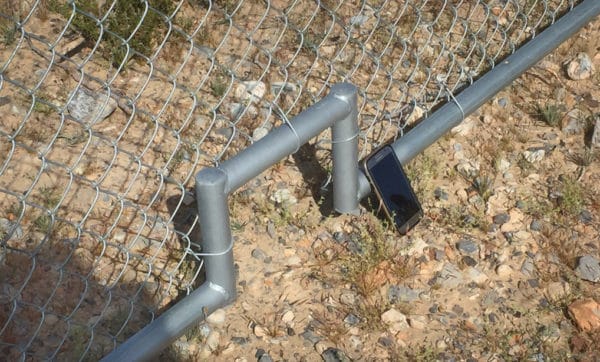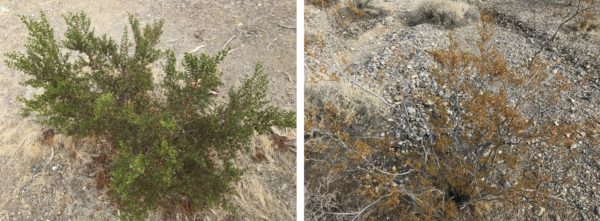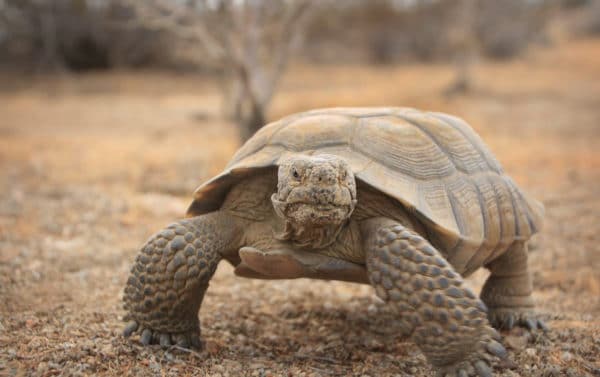Desert tortoises roam inside and outside a 15 MW community solar farm owned by Valley Electric Association in Nevada, thanks to fence openings that Bombard Renewable Energy built in.
The plants that desert tortoises need for survival are growing well inside the fenced area. Creosote plants used by tortoises for cover continued to grow last winter inside the fence, but were inactive outside the fence, as shown in these photos from a research project led by Dr. Dale Devitt, a soil and water scientist at the University of Nevada, Las Vegas.

Juvenile tortoises depend on cover plants to hide from predators, and tortoises of all ages may use them for shade, explained Dr. Jennifer Wilkening, a U.S. Fish and Wildlife Service biologist who oversees the project’s habitat protection plan. The research team began its plant research by planting 90 nursery seedlings of cover plants on the solar site, and providing supplemental water for a 3-month period.

Based on the photos of creosote plants, and similar photos for the cover plant bursage, Dr. Devitt said “it appears the solar facility is altering the microclimate and surface hydrology in ways that are currently extremely beneficial to both creosote and bursage, compared to the unaltered habitat that surrounds the facility.” He made the comment in a Valley Electric Association annual report on the habitat conservation plan for the site. Creosote and bursage “provide the majority of cover for the smaller animal life,” he explained.
Although the research team is not measuring the growth of herbaceous plants, grasses, and cacti, which Dr. Wilkening said are the primary food sources for tortoises, the image at the top of this story shows the growth of these plants in areas not shaded by panels. The fixed-tilt PV panels were placed with the lower edge 18 inches higher off the ground than the industry standard, to allow more vegetation to grow, notes a Fish and Wildlife Service post.
Dr. Devitt provided this context in an email to pv magazine:
“Although it is still early in the study, the preliminary results demonstrate that conditions inside the solar facility are less stressful on the plants, with both creosote and bursage staying active year-round. We believe the results demonstrate that a paradigm shift is needed in terms of how solar facilities are installed. Installations should be designed not only from an engineering perspective but a biological perspective as well.”
Tracking transmitters placed on four tortoises present on the site prior to construction have shown the tortoises located on either side of the fence on numerous occasions. Of the four, an adult male and female were last located together in a burrow; a sub-adult migrated five miles away and is no longer tracked; and a juvenile tortoise died of natural causes.
The tortoise-sized fence openings are 10 inches wide by 7 inches tall, and are spaced about every 260 feet, which is based on “how far tortoises have been known to walk along a fence line in the past, looking for an opening,”said Dr. Wilkening. Valley Electric Association notes on its website several additional measures, besides the fence openings and elevated panel height, that it has taken to protect tortoises and their habitat:
- Creating a temporary habitat for the tortoises during construction
- Not grading the site, thus leaving plants and their root systems intact
- Positioning equipment that requires maintenance on a single road through the site.
Desert tortoises are listed as threatened under the Endangered Species Act, and are thus protected. To develop a solar project on private land where there is a protected species, a solar developer must file a habitat conservation plan with the Fish and Wildlife Service. The desert tortoise, the Service says in a post, “is a long-lived, plant-eating reptile with a relatively low reproductive rate. Desert tortoises construct burrows and maintain their body temperature by spending most of their lives within them to avoid extreme temperatures.”
Other “eco-voltaic” projects
First Solar also used special fencing at its 550 MW Topaz project in California to let endangered San Joaquin kit foxes in and keep out their primary predator, coyotes. Research by First Solar on vegetation at the site has shown “greater percent live cover, less bare ground, and higher species diversity” than on surrounding stewardship lands. Researchers attributed higher forage production at the solar site to greater soil moisture, as “the array fields provide a shading effect similar to an orchard allowing the growing season to be extended.”
In North Carolina, “upside down” fencing at solar sites allows small wildlife to pass through, while keeping deer away.
Seeding of solar sites with pollinators has a growing fan base, particularly for smaller solar installations in parts of the country with enough rainfall to support lush fields of pollinator plants, along with the bees and butterflies that visit them.
This content is protected by copyright and may not be reused. If you want to cooperate with us and would like to reuse some of our content, please contact: editors@pv-magazine.com.








This is great news, I hope this becomes a requirement for all such locations.
We have land that would be suitable for a solar farm, but we live off grid.
How far can you be from the grid to lease land successfully?
Thanks,
PY Holden
Sundog Ranch
Bend, OR